by An Ard Rí, Scott Mehl, and Susan Flantzer
© Unofficial Royalty 2019
All portraits and photos are from Wikipedia unless otherwise noted.

The Royal Seat of San Lorenzo de El Escorial
The Royal Seat of San Lorenzo de El Escorial was built by King Felipe II of Spain for several purposes, one being the final resting place of the Kings of Spain. The complex includes a palace, basilica, monastery, and library. The Royal Crypt is located beneath the basilica and the convent. There are two separate Pantheons containing the remains. The Pantheon of Kings contains the remains of Kings and Queen Consorts who were also mothers of Kings of Spain. The Pantheon of Infantes is the resting place of other members of the Spanish Royal Family.
However, the royal remains are not initially interred in the Pantheons. Instead, the remains are taken to one of two decaying chambers (pudridero), where they remain for 30 to 40 years. The purpose of the pudridero is to reduce the size of the remains so that they will fit in lead chests, 3.2 feet/1 meter long and 16 inches/40 centimeters wide. The remains are then interred in the marble sepulchers or tombs in either the Pantheon of Kings or the Pantheon of Infantes. This procedure is overseen by the Augustinian monks of the Monastery of El Escorial.
********************
The Pantheon of Kings
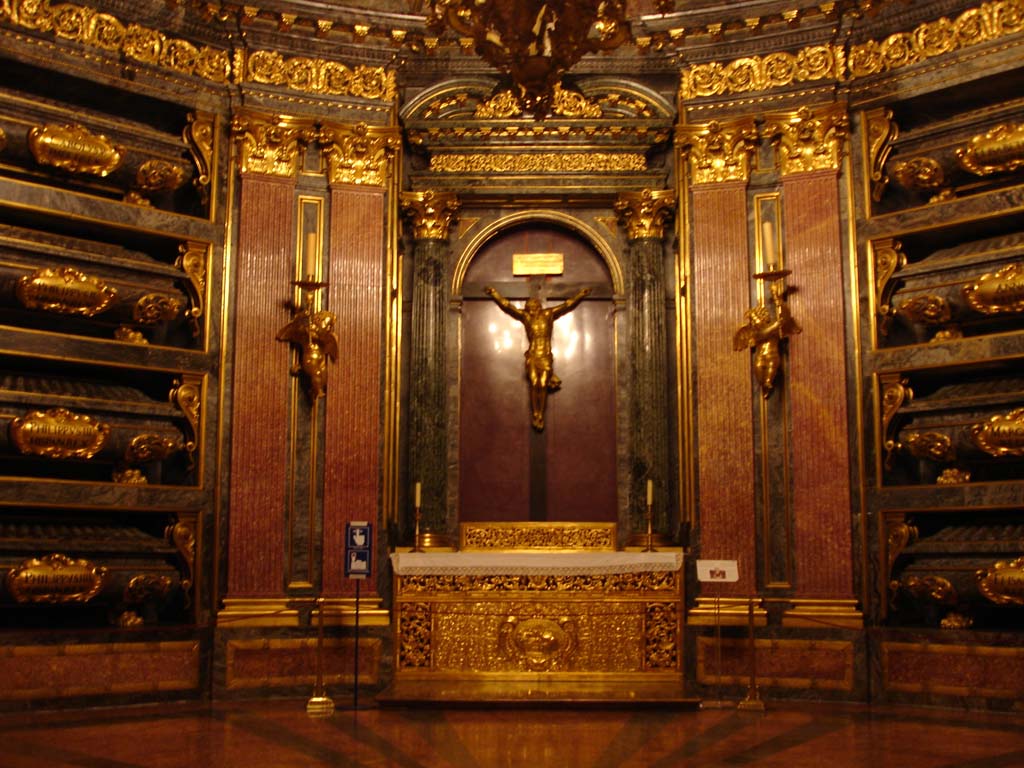
The altar inside the Pantheon of Kings

The layout of the Pantheon of Kings: The two empty sepulchers 25 and 26 will be used by Don Juan, Count of Barcelona and Maria Mercedes of Two-Sicilies, parents of King Juan Carlos; Source: https://i0.wp.com/upload.wikimedia.org/wikipedia/commons/thumb/2/27/La_Cripta-Ubicacion_de_las_urnas.jpg/670px-La_Cripta-Ubicacion_de_las_urnas.jpg?resize=625%2C559
The Pantheon of Kings is located beneath the basilica and consists of 26 marble sepulchers containing the remains of the Kings and Queens of Spain. As seen in the layout above, it is octagonally shaped, with the sepulchers stacked in six columns around the room. An additional two sepulchers are located above the entrance.
King Juan Carlos made exceptions for the final resting place of his parents. Although his father did not reign, Juan, Count of Barcelona was the heir apparent of his father King Alfonso XIII because both of his elder brothers renounced their rights of succession. When Alfonso XIII, who had lost his throne when the Second Spanish Republic was declared in 1931, knew that his life was coming to an end, he formally abdicated in favor of his son Juan, who became the pretender to the Spanish throne. The dictator Francisco Franco had declared that the monarchy would be restored upon his own death. However, Franco felt that Juan would be too liberal, so he passed over him and chose Juan’s son, Juan Carlos, as heir to the Spanish throne. Although Juan, Count of Barcelona never reigned, he is considered a de jure king and he and his wife are parents of a king.
The remains of King Alfonso XIII’s third son Juan, Count of Barcelona and daughter-in-law Maria de las Mercedes (the father and mother of the former King Juan Carlos I), lie in the pudridero, awaiting interment in the Pantheon of the Kings. When these remains are interred, all the sepulchers in the Pantheon of Kings will be filled. There have also been two Queen Consorts interred in the Pantheon of Kings who were not mothers of kings. No decision has been announced as to the final resting place of former King Juan Carlos I and his wife Queen Sofía or King Felipe VI and Queen Letizia, the present king and queen.
********************
The Pantheon of Infantes

The Pantheon of Infantes is a series of chambers housing the tombs of Infantes, Infantas, and Queen Consorts who were not the mothers of a future King. One of the chambers has a large white marble tomb shaped ‘like a birthday cake’. This structure was completed in 1888 and has niches for 60 tombs. This was originally used for young children who had not yet had their First Communion before they died. Elsewhere in the chambers are tombs of different shapes and styles, all in white marble. The Pantheon of Infantes has its own pudridero (decaying chamber) where the remains of the deceased stay for 20 to 30 years and then be interred.
********************
The Spanish House of Bourbon began its reign in 1700 and continues to the present day although there have been some lapses over the years. The first ruler of the House of Bourbon, King Felipe V, was born Philippe of France, Duke of Anjou. He was the second of the three sons of Louis, Le Grand Dauphin, the heir apparent to the throne of France. At the time of his birth, his grandfather Louis XIV was King of France. In 1700, Carlos II, King of Spain died childless with no immediate Habsburg heir. Philippe’s father Louis, Le Grand Dauphin had the strongest genealogical claim to the throne of Spain because his mother Maria Teresa, Infanta of Spain had been the half-sister of Carlos II. However, neither Philippe’s father nor his elder brother, Louis, Duke of Burgundy, could be displaced from their place in the succession to the French throne. Therefore, Carlos II named 16-year-old Philippe, Duke of Anjou as his successor in his will. There were periods over the years when Spain was not a monarchy and had a different form of government. Also, there were two Kings of Spain who were not from the House of Bourbon. Their burial information will be included below.
- Felipe V: first reign November 16, 1700 – January 14, 1724, abdicated in favor of his son
- Luis I: reigned January 14, 1724 – August 31, 1724
- Felipe V: second reign September 6, 1724 – July 9, 1746, reinstated upon the death of his son
- Fernando VI: reigned July 9, 1746 – August 10, 1759
- Carlos III: reigned August 10, 1759 – December 14, 1788
- Carlos IV: reigned December 14, 1788 – March 19, 1808, abdicated
- Fernando VII: first reign March 19, 1808 – May 6, 1808, forced to abdicate by Napoleón Bonaparte
- Joseph Bonaparte (José I Napoleón), brother of Napoleón Bonaparte, reigned June 6, 1808 – December 11, 1813, abdicated
House of Bourbon (1st restoration)
- Fernando VI): second reign December 11, 1813 – September 29, 1833
- Isabella II: reigned September 29, 1833 – September 30, 1868, deposed; provisional government until Amadeo I was elected King of Spain
- (Amadeo I: reigned December 4, 1870 – February 11, 1873, abdicated
First Spanish Republic: February 11, 1873 – December 29, 1874
House of Bourbon (2nd restoration)
- Alfonso XII: reigned December 30, 1874 – November 25, 1885
- Alfonso XIII: reigned May 17, 1886 – April 14, 1931, posthumous son of Alfonso XII, became King of Spain upon his birth
Second Spanish Republic: April 14, 1931 – March 28, 1939
Dictatorship of Francisco Franco: April 1, 1939 – November 20, 1975
House of Bourbon (3rd restoration)
- Juan Carlos I: reigned November 22, 1975 – June 19, 2014, abdicated
- Felipe VI: reigned June 19, 2014 – present
All pictures/photos of members of the Spanish Royal Family are from Wikipedia unless otherwise indicated. Since all but a few of the Spanish royals below are buried in the Pantheon of Kings or the Pantheon of Infantes at the Royal Crypt of the Monastery of El Escorial, the link is directly below and will not be listed in each entry.
********************
House of Bourbon
Felipe V, King of Spain, reigned 1700 – 1746

Felipe V was the first Bourbon King of Spain. In 1683, he was born Philippe of France, Duke of Anjou, the second of the three sons of Louis, Le Grand Dauphin who was the heir apparent to the throne of France. At the time of his birth, his grandfather Louis XIV was King of France. Felipe succeeded his childless cousin Charles III in November 1700. He married twice – first, to Maria Luisa of Savoy in 1701 and second, to Elisabeth Farnese, Princess of Parma in 1714. From the two marriages, he had 11 children. He abdicated on January 14, 1724, in favor of his son Louis I. However, Louis died 8 months later, and Philip returned to the throne, reigning until his death.
Felipe V died on July 9, 1746, at the El Escorial, Madrid. His remains are buried in the Royal Chapel of the Royal Palace of La Granja de San Ildefonso, near Segovia, Spain.
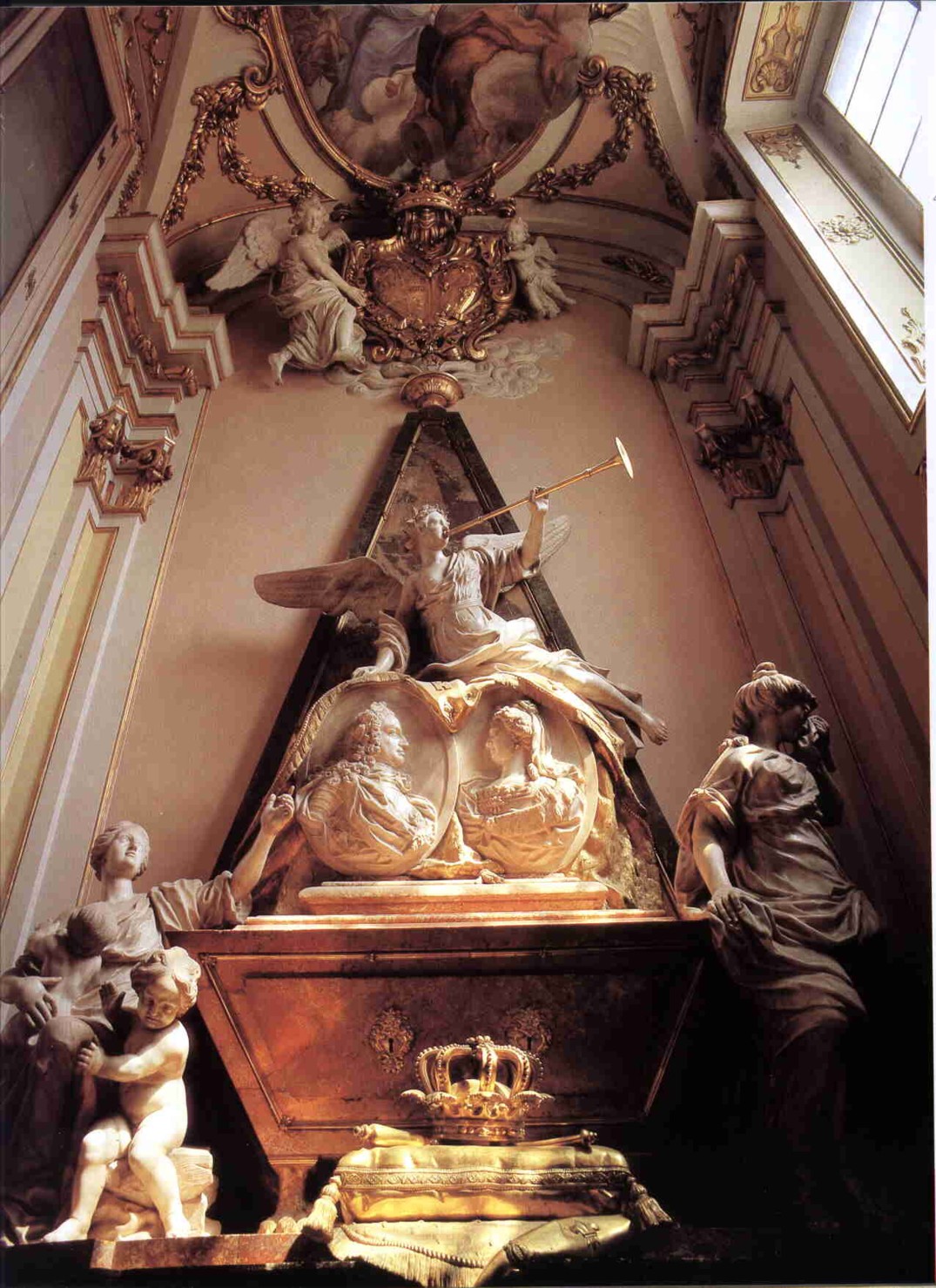
Tomb of Philip V and Elisabeth Farnese
Maria Luisa of Savoy, Queen of Spain

Maria Luisa of Savoy was the first wife of Felipe V of Spain and the mother of two kings, Luis I and Ferdinand VI. She died of tuberculosis on February 14, 1714. Her remains are buried in the Pantheon of Kings in the Royal Crypt of the Monastery of El Escorial.
Elisabeth Farnese, Queen of Spain

Elisabeth of Farnese was the daughter of Odoardo Farnese, Hereditary Prince of Parma and Dorothea Sophie of Neuburg. She married Felipe V of Spain in December 1714, as his second wife and was the mother of King Carlos III.
She survived her husband and died July 11, 1766, at the Royal Palace of Aranjuez. She is buried with her husband at the Royal Chapel of the Royal Palace of La Granja de San Ildefonso, near Segovia, Spain.
********************
Luis I, King of Spain, reigned January 14, 1724 – August 31, 1724

Luis I was the eldest son of Philip V of Spain and Maria Luisa of Savoy. On January 14, 1724, his father abdicated in favor of Louis. His reign of just 229 days is one of the shortest in history.
Luis I, just 17 years old, died from smallpox on August 31, 1724, at the Buen Retiro Palace in Madrid. His remains are buried in the Pantheon of Kings in the Royal Crypt of the Monastery of El Escorial.
Louise Elisabeth of Orleans, Queen of Spain
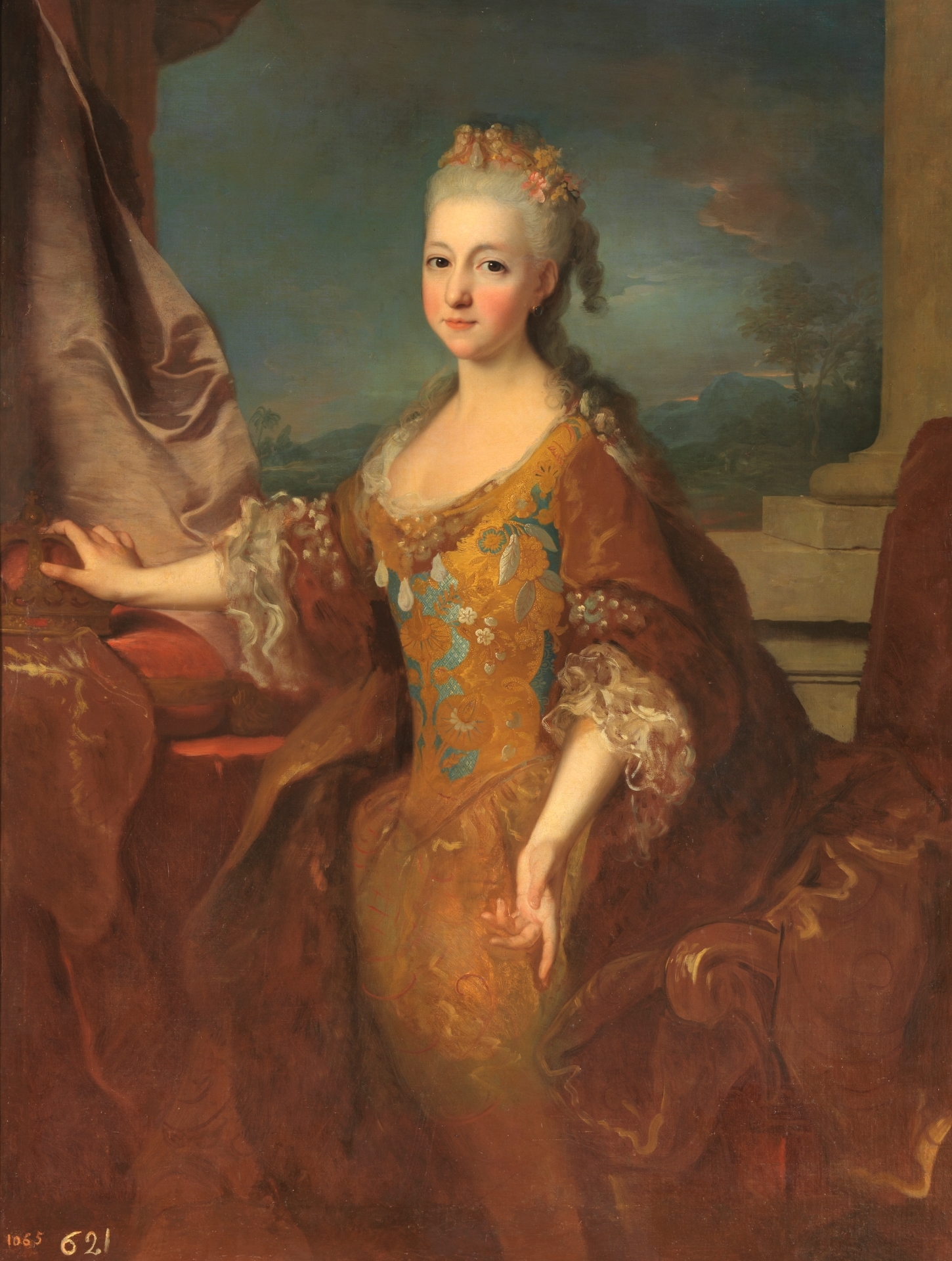
Louise Élisabeth d’Orléans was the daughter of Philippe II, Duke of Orléans, Regent of France and Françoise Marie de Bourbon. She married Luis of Spain on January 20, 1722.
Following the death of her husband, the Queen Dowager returned to France. Louise Élisabeth died from dropsy on June 16, 1742, at the Luxembourg Palace in Paris. Her remains were buried at the Church of Saint-Sulpice in Paris. In 1793, the church was sacked and the remains of Louise Élisabeth d’Orléans were desecrated.
********************
Ferdinand VI, King of Spain, reigned July 9, 1746– August 10, 1759
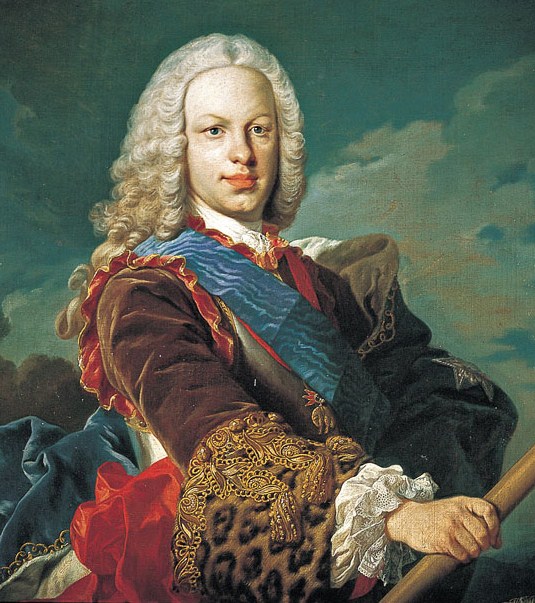
Ferdinand VI was a younger son of Felipe V and Maria Luisa of Savoy and the third Bourbon monarch of Spain.
King Ferdinand VI died on August 10, 1759, at the Castle of Villaviciosa de Odón, near Madrid. His remains are buried at La Iglesia de Santa Bárbara in Madrid, Spain
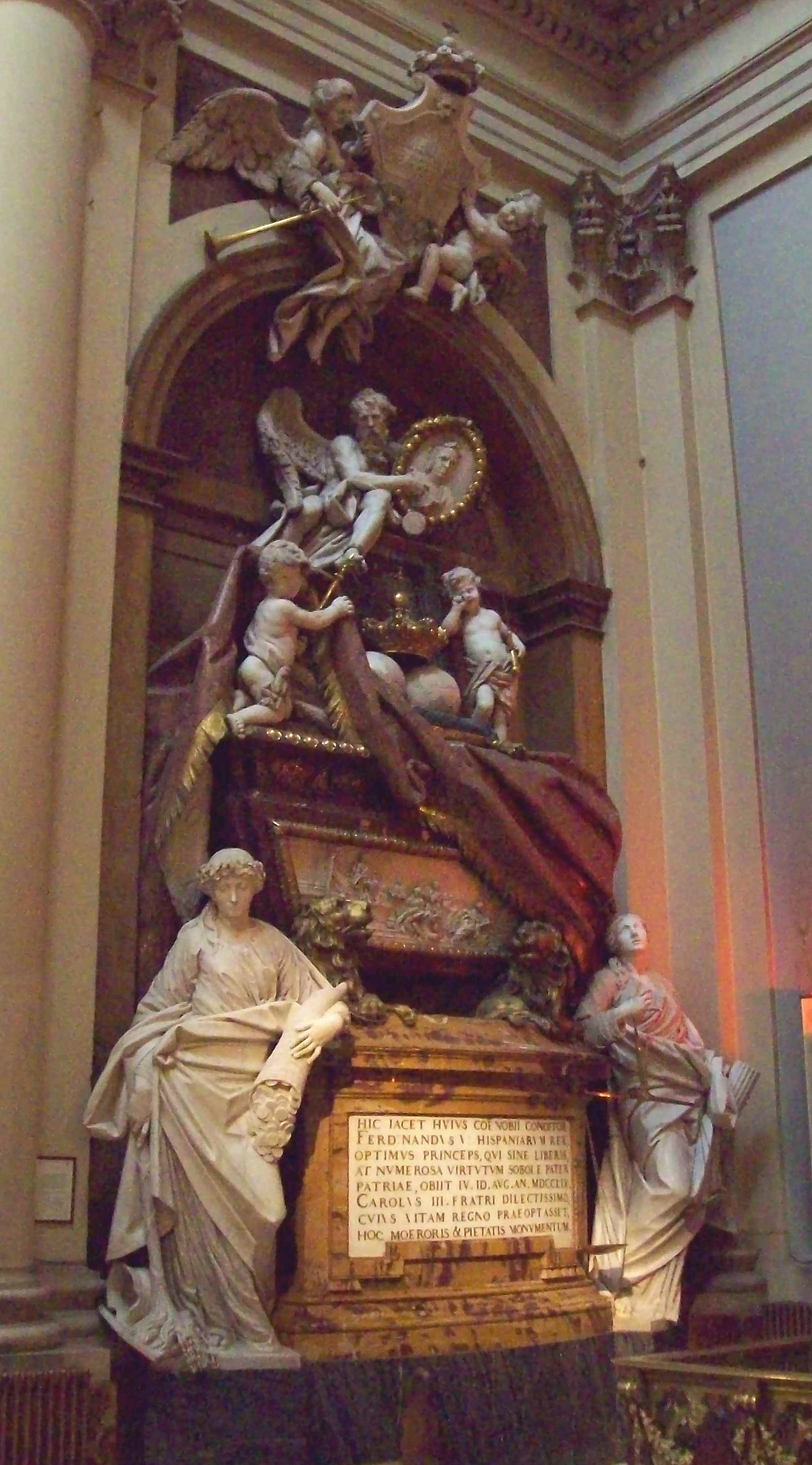
Tomb of King Ferdinand VI of Spain at the Church of Santa Barbara in Madrid
Bárbara of Portugal, Queen of Spain
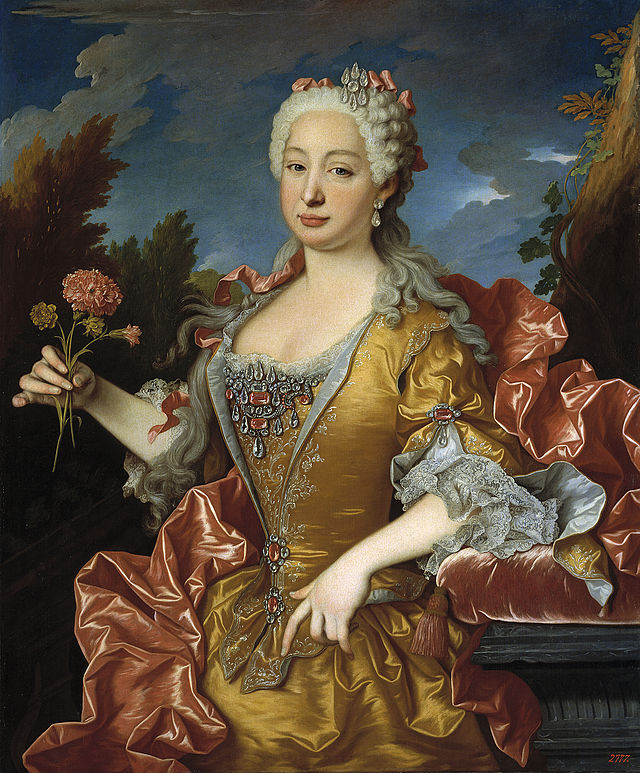
Bárbara de Braganza (Barbara of Portugal) was born an Infanta of Portugal, the eldest child of King Juan V of Portugal and María Ana of Austria. In 1729, she married the future Ferdinand VI of Spain.
Bárbara died at the Royal Palace of Aranjuez, on August 27, 1758. Her remains are buried at la Iglesia de Santa Bárbara in Madrid.

Tomb of Bárbara de Braganza at the Church of Santa Barbara in Madrid
********************
Carlos III, King of Spain, reigned August 10, 1759 – December 14, 1788

Carlos III was the eldest son of Philip V of Spain by his second marriage to Elisabeth Farnese. In 1731, Carlos became the Duke of Parma and Piacenza upon the death of his childless great-uncle. He was also King of Naples and Sicily from December 1, 1734 to August 10, 1759.
Carlos III died on December 14, 1788 at the Royal Palace of Madrid. His remains are buried in the Pantheon of Kings in the Royal Crypt of the Monastery of El Escorial.
María Amalia of Saxony, Queen of Spain

Maria Amalia of Saxony was the daughter of Augustus III of Poland, Elector of Saxony and Maria Josepha of Austria. In May 1738 she married the future Carlos III of Spain.
María Amalia died from tuberculosis on September 27, 1760, at the Buen Retiro Palace, Madrid. Her remains are buried in the Pantheon of Kings in the Royal Crypt of the Monastery of El Escorial.
********************
Carlos IV, King of Spain, reigned December 14, 1788 – March 19, 1808

Carlos IV was the second son of Carlos III and María Amalia of Saxony. In 1765, he married María Luisa of Parma.
Carlos IV abdicated on March 19, 1808, in favor of his son Ferdinand. In May 1808, Napoleon coaxed him into rescinding his abdication, and re-abdicating, this time in favor of Napoleon. He did, and this allowed Napoleon to name his brother Joseph as the new King of Spain. Following the Napoleonic Invasion of Spain, Carlos was taken to France and later settled in Rome. Carlos died on January 20, 1819, at the Barberini Palace in Rome. His remains were taken back to Spain and buried in the Pantheon of Kings in the Royal Crypt of the Monastery of El Escorial.
María Luisa of Parma, Queen of Spain
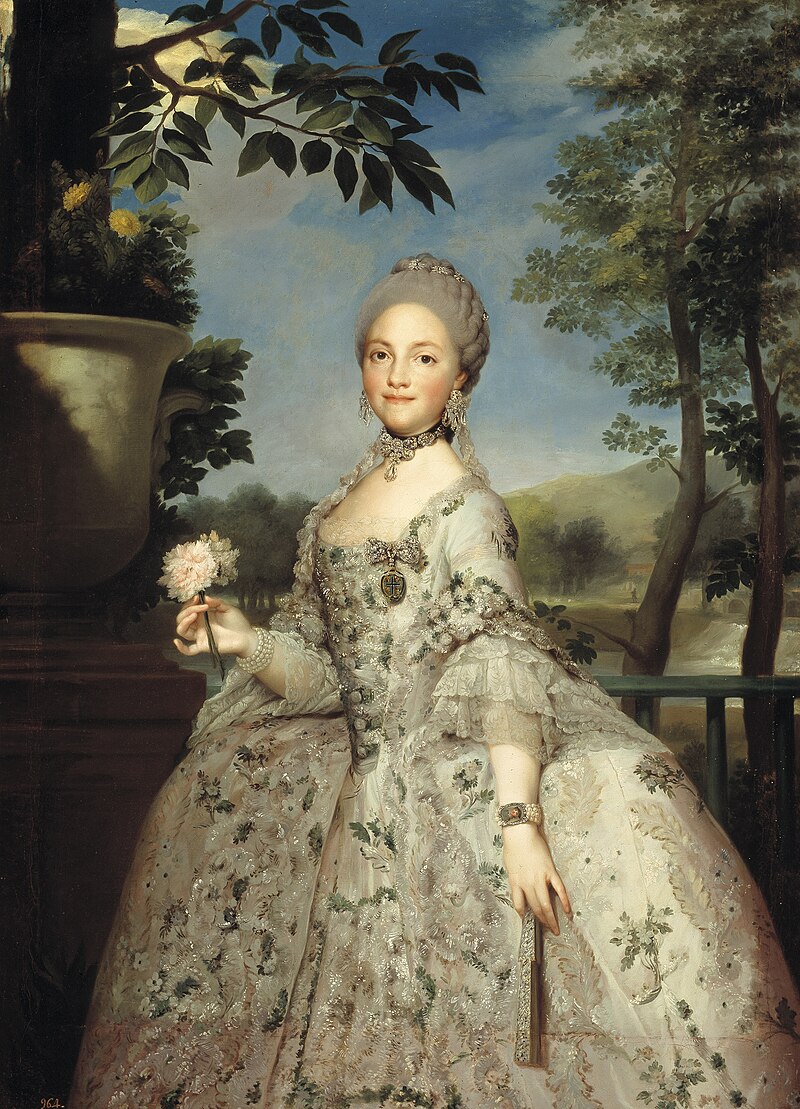
Maria Luisa was the youngest daughter of Philip I of Parma and Louise-Élisabeth of France. She married the future Carlos IV on September 4, 1765, at La Granja Palace.
Maria Luisa died in exile at the Barberini Palace in Rome on January 2, 1819. Her remains were taken back to Spain and buried in the Pantheon of Kings in the Royal Crypt of the Monastery of El Escorial.
********************
Ferdinand VII, King of Spain, reigned March 19, 1808 – May 6, 1808 and
December 11, 1813 – September 29, 1833

Ferdinand was the son of Charles IV and María Luisa of Parma. During the Napoleonic invasion of Spain, he was taken to France and held under guard at Bayonne. He reclaimed the Spanish throne in December 1813. King Ferdinand was married four times.
Ferdinand VII died on September 29, 1833, in Madrid. His remains are buried in the Pantheon of Kings in the Royal Crypt of the Monastery of El Escorial.
María Antonia of The Two Sicilies, Princess of Asturias, Infanta of Spain

María Antonia was the first wife of the future Ferdinand VII. They were married in October 1802.
María Antonia died from tuberculosis on May 21, 1806 at the Royal Palace of Aranjuez in Aranjuez, Spain. Her remains are buried in the Pantheon of Infantes in the Royal Crypt of The Monastery of El Escorial.
María Isabel of Portugal, Queen of Spain

María Isabel was born an Infanta of Portugal, daughter of King John VI of Portugal and Carlota Joaquina of Spain. On September 29, 1816, she married Ferdinand VII of Spain, as his second wife.
Maria Isabella died in childbirth (a stillborn daughter) on December 26, 1818, at the Palace of Aranjuez. Her remains are buried in the Pantheon of Infantes in the Royal Crypt of The Monastery of El Escorial.
Maria Josepha Amalia of Saxony, Queen of Spain

Maria Josepha Amalia of Saxony was the third wife of Ferdinand VII of Spain. They were married on October 20, 1819, in Madrid.
Maria Josepha Amalia died childless on May 18, 1829, at the Palace of Aranjuez. Her remains are buried in the Pantheon of Infantes in the Royal Crypt of The Monastery of El Escorial.
María Cristina of Bourbon-Two Sicilies, Queen of Spain, Queen Regent, 1833-1840
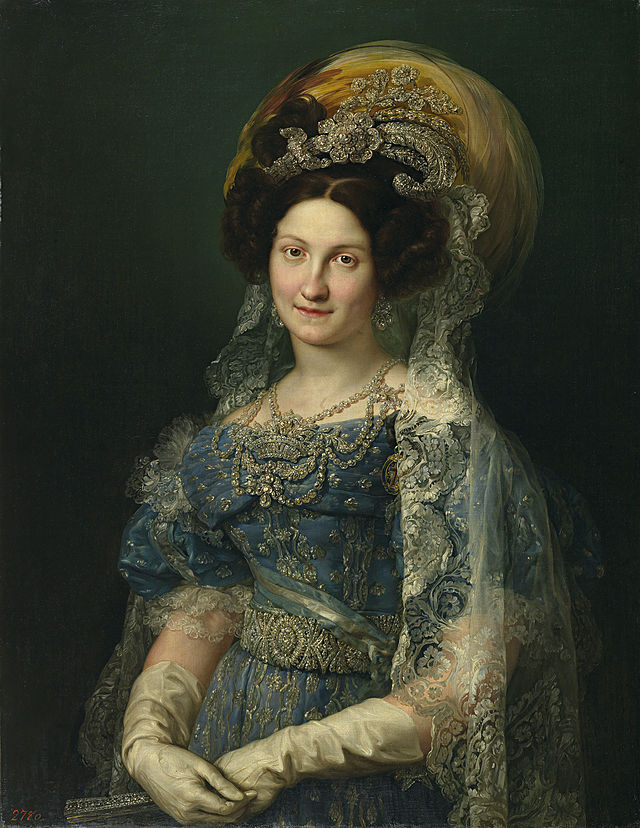
María Cristina of Bourbon-Two Sicilies was the fourth wife of King Ferdinand VII of Spain, and mother of Queen Isabella II. Following the death of her husband, she acted as Regent of Spain.
Queen María Cristina died in exile at Le Havre, France on August 22, 1878. Her remains are buried in the Pantheon of the Kings in the Royal Crypt of the Monastery of El Escorial.
********************
The House of Bonaparte
Joseph Bonaparte (José I Napoléon), King of Spain, reigned June 6, 1808 – December 11, 1813

Giuseppe Buonaparte was born January 7, 1768, son of Carlo Buonaparte and Maria Letizia Ramolino, and the elder brother of the future Emperor Napoleon Bonaparte. He married July Clary on August 1, 1794. His brother named him King of Naples in 1806, and on June 6, 1808, he was named King of Spain. He abdicated on December 11, 1813, and the House of Bourbon was restored to the Spanish throne.
After spending many years in the United States, Joseph returned to Europe. He died on July 28, 1844, in Florence. He was initially buried at the Basilica of Santa Croce in Florence, with his wife who died just a few months later. However, in 1862, Emperor Napoleon III had Joseph’s remains returned to Paris and buried near his brother, Emperor Napoleon I, at Les Invalides in Paris, France.

Tomb of Joseph Bonaparte; Credit – By Chris Waits – Flickr: Tomb of Joseph Napoleon I, CC BY 2.0, https://commons.wikimedia.org/w/index.php?curid=20287414
Julie Clary, Queen of Spain

Marie Julie Clary was born December 26, 1771 in Marseille, France, the daughter of François Clary and Françoise Rose Somis. She was the elder sister of Désirée Clary who became Queen Consort of Sweden and Norway. On August 1, 1794, Julie married Joseph Bonaparte, elder brother of Emperor Napoleon I, and future King of Spain.
Julie Carly Bonaparte died on April 7, 1845, just eight months after her husband. She was buried with him at the Basilica of Santa Croce in Florence. His remains were later moved to Les Invalides in Paris but hers remained at the Basilica with her daughter.
********************
1st Restoration of The House of Bourbon
Isabella II, Queen of Spain, reigned September 29, 1833 – September 30, 1868

Isabella II was the eldest daughter of King Ferdinand VII and María Cristina of Bourbon-Two Sicilies. On October 10, 1846, she was forced to marry her cousin, Francisco de Asís de Borbón. Isabella II was later deposed and abdicated on September 30, 1868.
Queen Isabella died on April 10, 1904, aged 73, in exile in Paris. Her remains were taken back to Spain and buried in the Pantheon of Kings in the Royal Crypt of the Monastery of El Escorial.
Francisco de Asís de Borbón, Duke of Cadiz, King Consort of Spain

Francisco was the husband and King Consort to Isabella II of Spain.
Francisco de Asís de Borbón died in exile at the Château of Épinay-sur-Seine, France on April 17, 1902. His remains are buried in the Pantheon of Kings in the Royal Crypt of the Monastery of El Escorial.
********************
House of Savoy
Amadeo I, King of Spain, reigned November 16, 1870 – February 11, 1873
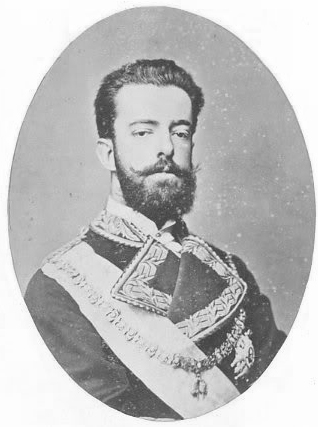
Amadeo was born May 30, 1845, the second son of King Victor Emanuel II of Italy and Adelaide of Austria. He was titled Duke of Aosta from birth. On May 30, 1863, he married Maria Vittoria dal Pozzo in Turin. After Queen Isabella II was deposed, the new Cortes elected Amadeo as the new King of Spain. His reign was short-lived, however, and he abdicated on February 11, 1873, and returned to Italy.
The Duke of Aosta died in Turn on January 18, 1890. He is buried in the Royal Crypt at the Basilica of Superga in Turin, now in Italy.
Maria Vittoria dal Pozzo, Princess della Cisterna, Queen of Spain

Maria Vittoria dal Pozzo was born in November 1870, the daughter of Carlo Emanuele dal Pozzo, Prince della Cisterna and Countess Louise de Merode. In May 1863, she married Prince Amadeo of Savoy, Duke of Aosta, the future King of Spain.
The Duchess of Aosta died on November 8, 1876, in San Remo. She is buried in the Royal Crypt at the Basilica of Superga in Turin.
Maria Letizia Bonaparte, Duchess of Aosta

Maria was the second wife of Amadeo, Duke of Aosta (formerly King Amadeo of Spain). She was born in November 1866 to Napoleon Joseph Bonaparte (a nephew of Emperor Napoleon Bonaparte), and Princess Maria Clotilde of Savoy (a daughter of King Victor Emmanuel of Italy). She married the Duke of Aosta, her uncle, on September 11, 1888, in Turin. The couple had one son.
The Dowager Duchess of Aosta died on October 26, 1926, in Italy. She is buried in the Royal Crypt at the Basilica of Superga in Turin.
********************
First Spanish Republic
February 11, 1873 – December 29, 1874
********************
2nd Restoration of The House of Bourbon
Alfonso XII, King of Spain, reigned December 29, 1874 – November 25, 1885

Alfonso was the only surviving son of Isabella II and Francisco de Asís de Borbón. He became King of Spain in December 1874 following the collapse of the First Spanish Republic. Alfonso XII was married twice.
Alfonso XII died of tuberculosis on November 25, 1885, at the Royal Palace of El Pardo. His remains are buried in the Pantheon of Kings in the Royal Crypt of the Monastery of El Escorial.
Maria de la Mercedes of Orleans, Queen of Spain
Mercedes was the daughter of Antoine d’Orléans, Duke of Montpensier and Infanta Luisa Fernanda of Spain. She was also a granddaughter of Louis Philippe I, King of the French. On January 23, 1878, she married her cousin Alfonso XII of Spain in Madrid.
Mercedes died at the Royal Palace of Madrid from tuberculosis on June 26, 1878. Her remains were originally buried in the Pantheon of Infantes at El Escorial, but in November 2000, were interred at the Cathedral of Saint Mary the Royal of La Almudena in Madrid.

Tomb of Queen Mercedes at the Almudena Cathedral
Maria Christina of Austria, Queen of Spain, Queen Regent, 1885-1902
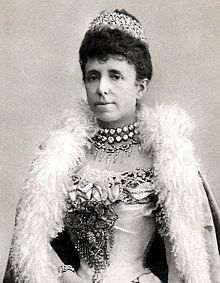
Maria Christina was a daughter of Archduke Karl Ferdinand of Austria and Archduchess Elisabeth Franziska of Austria. In November 1879 she married Alfonso XII of Spain at the Basílica de Nuestra Señora de Atocha in Madrid.
Maria Christina died on February 6, 1929, at the Royal Palace of Madrid. Her remains are buried in the Pantheon of Kings in the Royal Crypt of the Monastery of El Escorial.
********************
Alfonso XIII, King of Spain, reigned May 17, 1886 – April 14, 1931

Alfonso XIII was the only surviving son of Alfonso XII and María Cristina of Austria. He was King of Spain from birth under the regency of his mother. In May 1906 he married Princess Victoria Eugenie of Battenberg in Madrid.
The King died in exile in Rome on February 28, 1941. His remains were first interred at the Church of Holy Mary in Monserrato of the Spaniards, in Rome. In January 1980, his remains were taken back to Spain and buried with full honors in the Pantheon of Kings in the Royal Crypt of the Monastery of El Escorial.
Victoria Eugenie of Battenberg, Queen of Spain
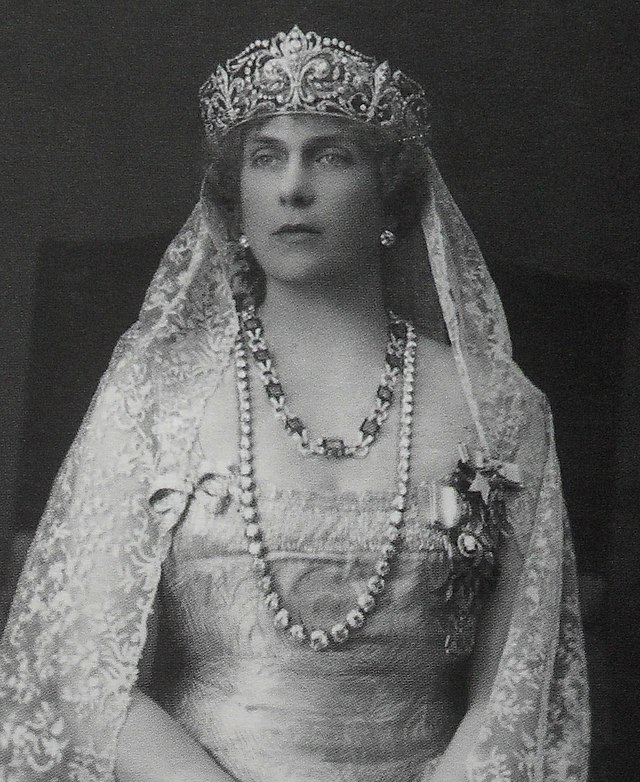
Victoria Eugenie, or ‘Ena’ as she was known, was the daughter of Prince Henry of Battenberg, Princess Beatrice of the United Kingdom, and a granddaughter of Queen Victoria. On May 31, 1906, she married King Alfonso XIII of Spain at the Royal Monastery of San Geronimo in Madrid.
The Spanish Royal Family went into exile on April 14, 1931, following the proclamation of the Second Spanish Republic. Queen Ena died in Lausanne, Switzerland on April 15, 1969, aged 81. Her remains were buried first at the Sacred Heart Church in Lausanne. However, in April 1985 her remains were taken back to Spain and buried in the Pantheon of Kings in the Royal Crypt of the Monastery of El Escorial.
********************
Infante Juan, Count of Barcelona
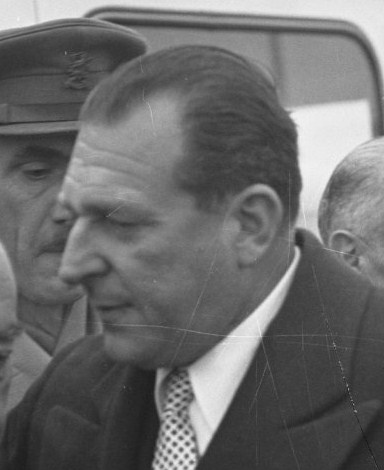
Infante Juan or as he was better known, the Count of Barcelona, was the third surviving son of Alfonso XIII and Victoria Eugenie of Battenberg. In October 1935, he married Princess Maria de las Mercedes of Bourbon-Two Sicilies. They were the parents of King Juan Carlos of Spain.
The Count of Barcelona formally renounced his rights to the Crown in May 1977. He died on April 1, 1993, from laryngeal cancer at the University Clinic of Navarra in Pamplona, Spain. His remains are currently in the pudridero at the Pantheon of Kings in the Royal Crypt of the Monastery of El Escorial.
Princess Maria de las Mercedes of Bourbon-Two Sicilies, Countess of Barcelona
Princess Maria de las Mercedes was the daughter of Prince Carlos, Duke of Calabria and Princess Louise of Orléans. She married Infante Juan of Spain in Rome on October 12, 1935.
The Countess of Barcelona suffered from poor health, and in 1985 she was forced to use a wheelchair for the rest of her life. She died on January 2, 2000, at the royal residence, La Mareta, in Lanzarote, where the royal family went to celebrate the New Year. The Countess was buried with the full honors of a Spanish Queen. Her remains are currently in the pudridero, and will eventually be interred in the Pantheon of Kings in the Royal Crypt of the Monastery of El Escorial.
********************
This article is the intellectual property of Unofficial Royalty and is NOT TO BE COPIED, EDITED, OR POSTED IN ANY FORM ON ANOTHER WEBSITE under any circumstances. It is permissible to use a link that directs to Unofficial Royalty.

